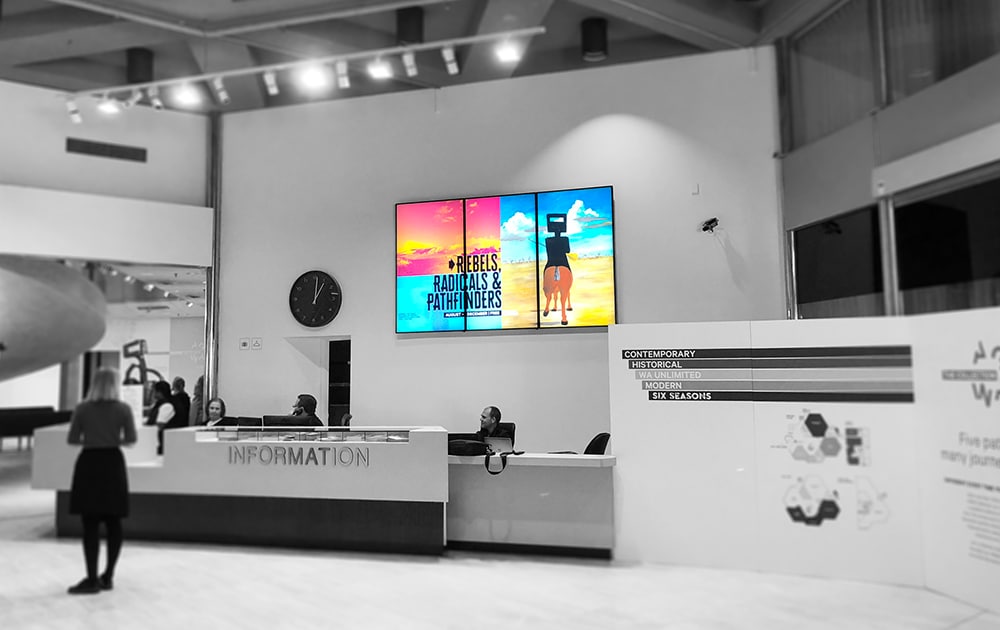
When ordering at a drive-thru or walking into a restaurant, heading to an airport, or going to a shopping centre, chances are, you have seen the bright and engaging digital displays on the windows and walls of these places and might even have interacted with one.
Many businesses have opted to use digital signage to advertise their products and services. It has been proven to be effective in increasing sales and improving operational efficiency. But what is Digital Signage?
Digital signage are electronic signs that convey information, images, videos, and more to audiences. It uses technologies such as LCD, LED, or projection screens to display content that can inform, educate, entertain, instruct and advertise to the targeted audience. Digital signage can be found in public spaces, transportation systems, museums, stadiums, retail stores, hotels, restaurants, and corporate buildings.
Digital signage solutions typically consist of four main components: display screens, media players, content management software, and digital content.
Display
The LCD and LED screens showcasing your content are called displays. This tech solution can vary in size depending on its purpose and intended environment. Typical displays can range from 10” up to 98” and can be used individually or combined as one massive display screen or video wall. They are designed to run in either portrait or landscape orientation and can also be interactive (i.e. touch or voice-activated) depending on the screen model. Another important feature of display screens is higher brightness levels. While residential TVs typically have a brightness level of around 250 nits, Digital Signage displays can produce up to 4000 nits, in order to show bright colourful content in even the brightest lighting conditions. Unlike residential TVs, digital signage displays can run from 16-24 hours a day and are intended for commercial use. Most TV warranties get voided immediately once used in a commercial space. Whereas, digital displays come with a minimum 3-year commercial-grade warranty.
Media Player
Media players are the small electronic device behind the display that renders the content. Depending on the model and particular requirements, the price of media players can range from $500 AUD to $1500 AUD. Most, if not all, digital media players can connect to the internet, enabling the display screens to access cloud-based content management systems (CMS) which allow users to safely store, schedule, and update their digital signage content. Some digital displays include System-on-Chip (SoC) which means that they have built-in media players. This reduces the points of failure as well as the cost.
Content Managment Software
Digital signage software typically takes the form of a Content Management System (CMS) and is an integral part of any digital signage solution, allowing users to distribute content across their digital displays. Choosing the right software has a huge impact on the users’ digital signage experience. Firstly, it is important to know what content is going to be shown on the digital displays and how often it will need to be updated. You should also consider how many screens are in your network, and how you want to manage them. For clients looking to get started with digital signage, we recommend a cloud-based software like Signagelive to manage your digital signage network remotely, create layouts, and organise and schedule content.
Content
Digital signage content includes any images, videos, templates, websites, customised touchscreen applications, or animations that are shown on a digital display. It is the message that is relayed to the target audience. A strong content strategy will result in an effective digital signage display that can attract customers and even improve operational efficiency. The content you want to display often determines what type of technology is required to complete the digital signage solution and ensure that the system is suited for its purpose. When planning content for digital signage, it’s important to consider the duration, schedule, and relevance to the target audience.
A growing number of companies worldwide are utilising digital signage solutions. QSRs, shopping malls, transport, medical, and education facilities use digital signage to effectively relay information to their audience and increase engagement.
Want to know more?
At Amped Digital, we deliver quality digital signage solutions suited to any type of business. We are passionate about creating well-designed digital signage that can help businesses boost brand recognition, optimise customer service, and create unique experiences for their customers. Get in touch with one of our friendly team members and get started on your digital signage journey!










